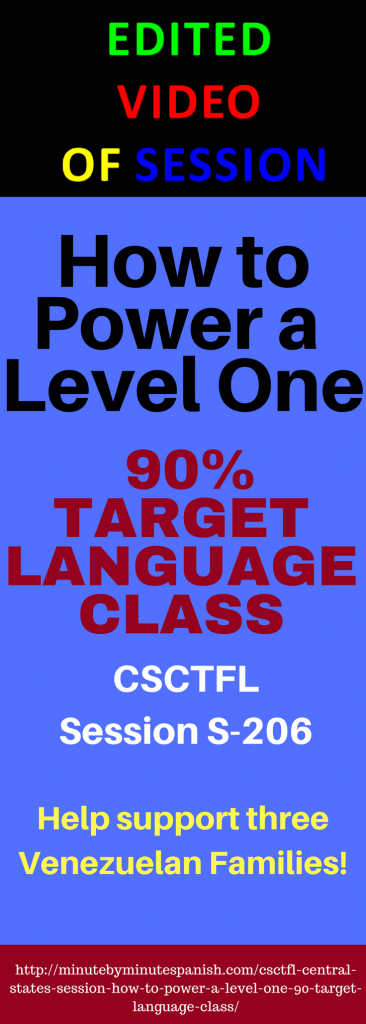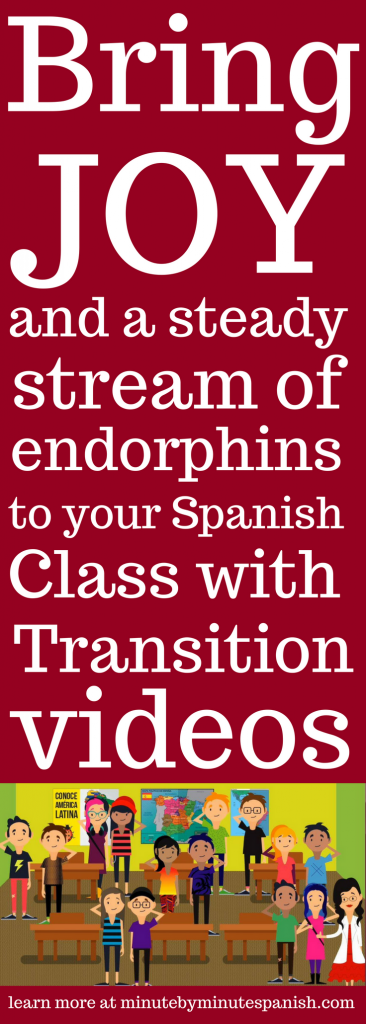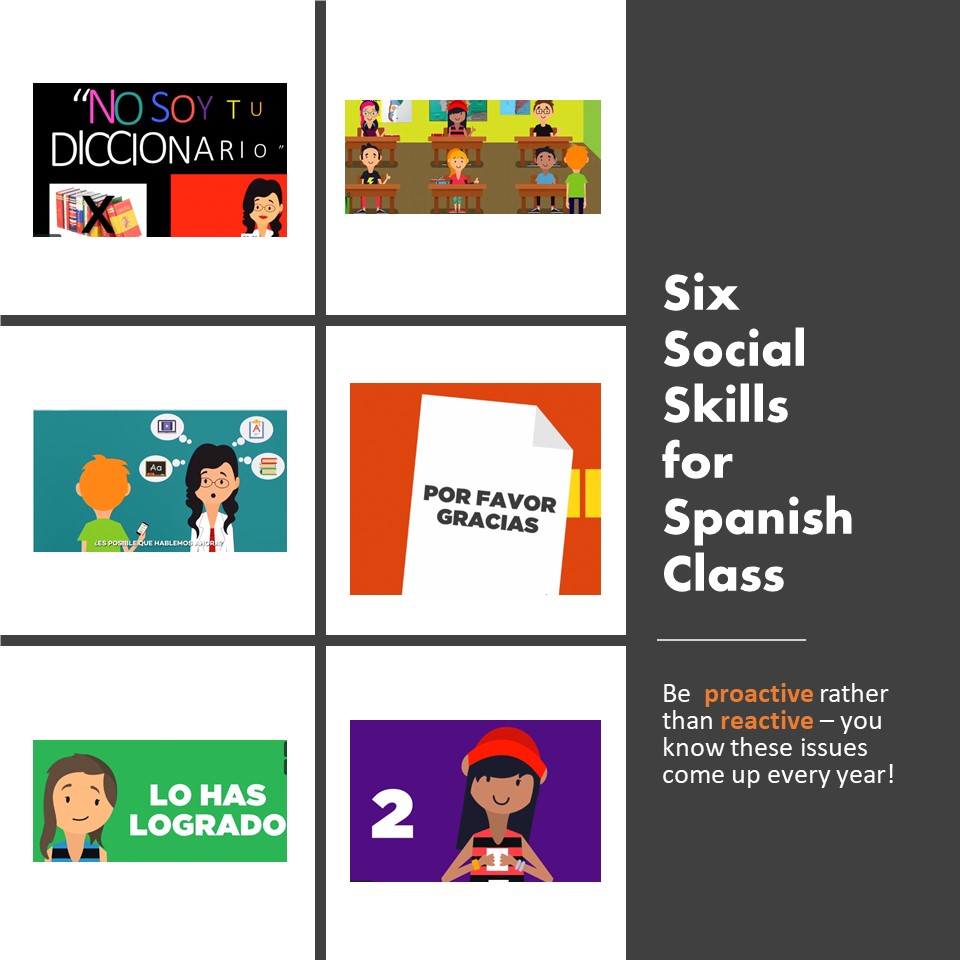
Stay on Task and in the target language with transition videos.
Spanish Lessons

Stay on Task and in the target language with transition videos.
Handout for central states 2018 Friday S-206



Two days before I return to year 23 of my teaching middle school, I didn’t want to take the time to answer a teacher inquiry: “What behavior management tool do you use with your middle school students? I’m trying to find a way to motivate my students to participate more and to work together.”
I am learning new names, making seating charts, reading IEPs , and making detailed seating charts of everyone’s health alert for substitutes. I am planning my presentation to parents while 700+ new students tour our building.
But the question haunted me and here is why. If you put the time into prepping your lesson, setting the expectation of working together, providing many activities in class, and appeal to their innate curiosity, they will work together and be motivated. This is not a “what” question but a “how “question “how do I prep a lesson that engages?” “How do I set the expectation of working with everyone in the class so clearly that noone dares to whine or challenge me on their partners of the week?” “How do I ” rather than “what will fix my not doing the how.”
You don’t need a Spanish One Class Management tool if you do the following:
1. From day one students have a seat partner and a random weekly partner. (Here is my explanation of random partners spoiler alert – it will help them to get along where they end up working.) At least 5 – 7 times a class period they turn to their seat partner to practice what is on the board. They are able to participate because I assign the partners and the dialogues are clearly on the board. I am able to walk around the room and circle because of #2. There is no room for not knowing what to do – it is all on the board. No time lost finding a partner – very neat and controlled. From day one it is my expectation of working together, of choral responses, of always having visual support on the board.
2. Make a daily tech guide so that your class routines and the day’s activities all set up for you to use with your remote presentation device or clicker. You can be anywhere in the classroom, like behind the ones who go off task. Stand behind them and keep on teaching. Drench them choral responses, tell them to turn and tell their partner, rarely do hands go up for individual responses if one student is answering, 29 are not answering. With a daily tech guide you can do so much more. Click here to see videos of my lessons. You will be able to keep the class moving through so many more activities than usual with your daily tech guide. Make a template and save it as “day 13” and the next one “day 14” – for ideas on such a template, go here.
You will be able to keep the class moving through so many more activities than usual with your daily tech guide. Make a template and save it as “day 13” and the next one “day 14” – for ideas on such a template, go here.
3. Your transitions (the major time for things to fall apart) are seamless with slides and transition videos. The music releases endorphins and makes everyone happier. They are singing during the transitions rather than going off task. See here. If you need help funding anything check this out: https://www.tptclassfund.com

4. I do not want to be replaced by a computer language program, and most likely neither do you. Computer programs drill, excellent teachers reveal in such a way that students want to know if they are right. I reveal vocabulary, not just give a list. I tell them that X is tricky, be sure to lookout for Q and they are gleeful when they do. Many activities involve spontaneous speech where partner A see something on the board. Partner B has his or her back to the board and makes guesses while A provides feedback. Students love guessing and getting things right. I have a daily review of previous vocab and will change one little detail so it doesn’t become rote – they love not falling into the predictability trap. I frequently wonder aloud how long something will take and they pull together to exceed my prediction.
In the 80’s I interviewed with a boss who explained her teaching style like this:
“Today you are going to learn X. This is X. That is X. Copy X. Repeat X. Answer me, what is X? In summary, X is this.” I think of that when I see teachers explain something, give a worksheet, and go over the answers with no joy in the process of what students were thinking. It reminds me of that boss from over 30 years ago.
5. Once you have taught something, note the mistakes so in the next class you can generally refer to it. Otherwise any correction in class is personalized and parents are told “She hates me.”
For example, I introduce new vocabulary as a dictation, I point to vowels and they try to spell the word, then check the spelling on the other side. Students tell me ‘lo acerté’ o “no lo acerté.” I then will ask how many of you put an ‘s’ instead of a ‘c’? That is the most common mistake – relieving them of feeling bad that they didn’t get it right. Engage them with discovery.
Discovery motivates students intrinsically and is so much better than external rewards. External rewards tell students “this is so boring I have to bribe you” and eventually your first reward system will bore them and you will have to up the ante. Forget the what and do the how. You and your students will be glad you did.


This is a vintage power struggle that you will lose if you respond to the comment rather than openly acknowledging the tactic the student is doing.
From my book “Teacher Dialogues” I post two signs up and discuss them during a neutral time.
Now, let’s apply the four kinds of responses by students to the situation that a student is once again late to class. The bell has rung, you are giving directions to the rest of the class, a student slips into her chair, and you neutrally tell her to see you at the end of class about being late.
DENY: “No, I’m not!”
“That’s not true, just a little late . . .”
RESPONSE:
“OK, the little child part of you is reacting by denying [as I walk over to the posters]. I need you to take a step towards being a mature teenager and apologize. Can you do that for me today? No, well, perhaps tomorrow will be better—I believe in you.” [Then I would continue on with the lesson and let the other students tell her to hush and not be a baby.]
DIVERT: “Junior is texting!”
“But yesterday she was late.”
“Everyone is doing their homework before you check it.”
RESPONSE:
“OK, the little child part of you is reacting by diverting [as I walk over to the posters]. I need you to take a step towards being a mature teenager and apologize. Can you do that for me today? No, well, perhaps tomorrow will be better—I know you will get there.” Then I would continue on with the lesson and let the other students tell her to hush and not be a baby.
CHALLENGE: “Why do you always act like the first few minutes are important—you don’t do anything during them.”
“No other teacher cares if someone is 20 seconds late.”
” You are picking on me.”
RESPONSE:
“OK, the little child part of you is reacting by challenging me [as I walk over to the posters]. I need you to take a step towards being a mature teenager and apologize. Can you do that for me today? No, well, perhaps tomorrow will be better—I have seen many glimpses of you being very mature for your age, and I know I will see them again.” [Then I would continue on with the lesson and let the other students tell her to hush and not be a baby.]
THREATEN: “My mother says if you pick on me again she is calling the principal.”
“I’m gonna sue you for making fun of my being fat and walking so slow.”
“I’m telling my uncle the lawyer that you only single me out because I am . . .”
RESPONSE:
“OK, the little child part of you is reacting by threatening me, and it sounds like today just isn’t working well for you [as I walk over to the posters] but I need you to take a step towards being a mature teenager and apologize. Can you do that for me today? No, well, perhaps tomorrow will be better. I believe you will be able to do this and have a bright future. [Then I would continue on with the lesson and let the other students tell her to hush and not be a baby.]
After all of this repetition, you probably have the solution part memorized. Great! Now memorize these words: deny, divert, challenge, and threaten. Begin to closely observe others; practice labeling reactions in your mind and soon the correct response will fall out of your mouth naturally!



When I started teaching in the 80’s, teachers were expected to be caring adults providing boundaries and feedback about appropriate behavior.
In 2020, when responding to a student’s inappropriate behavior, I am contacted by parents about their concern that I don’t like their child. I fear that students are learning their social skills from social media; many are not making the correct leap from talking to Alexa to talking to their teacher.
After thirty plus years of teaching the same age group, I can predict certain topics that come up every year and rather than correct a student for being inappropriate, I proactively give direct instruction on social skills using catchy musical videos to everyone. Thus, when a student is interrupts, or treats me like a walking dictionary, the rest of the class breaks out into song and the correction is considered impersonal rather that a personal correction.
We, my Venezuelan friends and I, have created six musical videos sung in Spanish to demonstrate these skills. See the video below about the Venezuelans who make the songs and videos and how all net proceeds go to them as this is my charity work.
It includes offering to escort the new student to his or her next class, offering to eat lunch together, sharing recent classwork, and welcoming them to the class.
Many students write emails to teachers as if they were texting a friend. This social skill video reminds students to identify themselves, address the teacher by name and use querido, atentamente, por favor, gracias. The video reminds them that their future bosses may not know how capable they are because their poor manners.
This will save you from middle school teacher burnout! I share rooms and am rushing into set up my laptop and complete a variety of housekeeping tasks and it can take my last ounce of patience when a student just starts talking to me in a long-winded story. Now they know to first ask if now is a good time and if it isn’t I always circle back to them. This has made for much more pleasant relationships and a smooth start to class. It may very well help them to keep future jobs. Parents tell me they love it when I explain it to them at Open House and they also use it with me!
The best way to ensure that students get along in a class is to use random grouping cards and explain to them the importance of learning how to work with everyone. All of the directions are included along with the video. Be the adult in the class and set the expectation that they must work with anyone for a week at a time and they will. Let’s fight the growing tide of selected social media narrowing the variety of exposure that students have to different kinds of people. By the end of the year, substitute teachers and students will comment on how well the class gets along.
We must give our students direct instruction on how to congratulate one another in the target language.
Use this musical video, and ‘en hora buena’ and ‘felicitaciones’ will roll off their tongues at appropriate times.
Let’s further examine this issue of asking Spanish teachers to be a walking dictionary.
Students in our classes are accustomed to asking Alexa questions at home and getting immediate answers. When I first started teaching, we spent a couple of days using paper dictionaries and teaching them how to look up infinitives and other basic skills. Now we train them to use Word Reference while they may still very well be ‘Google Translating’ their homework.
I even had a parent send me a google translated e-mail – and she has never studied Spanish. She thought I would be so impressed! But I digress.
We train our students to ask three before me or use three before me or write their name on the board with the word they need help with in the hopes a classmate will help out.
But the best solution is to teach them the song “No soy tu diccionario” and when they forget and ask you how to say something the rest of the class breaks out into the song.
It works!
Every year students want to learn how to insult one another in Spanish. They will ask me how to say “stupid” in Spanish so that they can insult one another.
You do you with your teaching voice, but my response, said with the sweetest, most sincere drippy concern of a grandmother, “oh honey, I see why you feel that way about yourself but it would break my heart to have you talk about yourself that way, no I just can’t add to your negative self-talk – you are just too good!” This puts the kid in checkmate – can’t admit he/she wants to use it for others and the whole class is laughing about my thinking he/she wants to call himself/herself stupid when clearly the intention is to insult someone else.
All net proceeds help three Venezuelan families – meet them in this video as they open three boxes I sent to them.
If you want to read more about class structure and transition videos, read my blog here.
If your school won’t provide you with these tools, you may consider this:





A teacher asked, “Does anyone have an idea for weekly participation like bell ringers that can be easily collected or stamped? I have almost 200 kids and it’s a lot! I want to motivate them to speak and participate…”
.


| Cookie | Duration | Description |
|---|---|---|
| cookielawinfo-checkbox-analytics | 11 months | This cookie is set by GDPR Cookie Consent plugin. The cookie is used to store the user consent for the cookies in the category "Analytics". |
| cookielawinfo-checkbox-functional | 11 months | The cookie is set by GDPR cookie consent to record the user consent for the cookies in the category "Functional". |
| cookielawinfo-checkbox-necessary | 11 months | This cookie is set by GDPR Cookie Consent plugin. The cookies is used to store the user consent for the cookies in the category "Necessary". |
| cookielawinfo-checkbox-others | 11 months | This cookie is set by GDPR Cookie Consent plugin. The cookie is used to store the user consent for the cookies in the category "Other. |
| cookielawinfo-checkbox-performance | 11 months | This cookie is set by GDPR Cookie Consent plugin. The cookie is used to store the user consent for the cookies in the category "Performance". |
| viewed_cookie_policy | 11 months | The cookie is set by the GDPR Cookie Consent plugin and is used to store whether or not user has consented to the use of cookies. It does not store any personal data. |